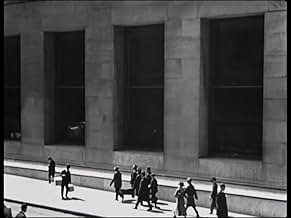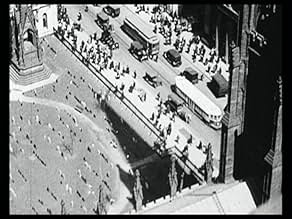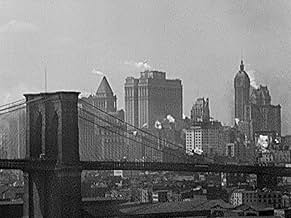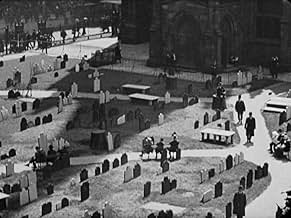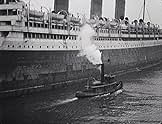PUNTUACIÓN EN IMDb
6,6/10
1,7 mil
TU PUNTUACIÓN
Añade un argumento en tu idiomaThis groundbreaking silent documentary captures the beauty and majesty of the New York City in its streets, skyscrapers, bridges, rail yards and harbors.This groundbreaking silent documentary captures the beauty and majesty of the New York City in its streets, skyscrapers, bridges, rail yards and harbors.This groundbreaking silent documentary captures the beauty and majesty of the New York City in its streets, skyscrapers, bridges, rail yards and harbors.
- Dirección
- Guión
- Premios
- 1 premio en total
Reseñas destacadas
This experimental movie of Paul Strand about Manhattan is extremely important to the future generations of directors. Paul Strand is like a bird in Manhattan, showing the daily life and the most characteristic points of it. Manhattan is shown in a Bird's eye shot(I think that it's the name in English, kind like the public was God himself. I never went to Manhattan, but in 10 minutes I visited, understood and felt Manhattan. It is amazing how in such a short time, he can illustrate, in a interesting and original way, this mediatic place. Paul Strand is like a magician that takes photos of Manhattan and give life to them. A great short that definitely is a mark on cinema's experimental history.
Here's the beginning of the city symphony film, which would include "Berlin: Symphony of a City" (1927) and "The Man with a Movie Camera" (1929). Although "Manhatta" doesn't contain the rapid rhythmic montage of some of the later city symphonies, it does have a sort of slower, poetic rhythm to it. It's discernible from a travelogue in that it has something to say about its city, other than it's a nice place to visit. The steady progression of images interloped with poetic intertitles taken from Walt Whitman produce the rhythm.
From the still photographer Paul Strand and the painter and still photographer Charles Sheeler, their view of Manhattan is, of course, modern. The shots are of skyscrapers and the inter-workings of the city. One is Strand's 1915 still photograph "Wall Street" come to motion. The composition, camera placement and observation of light and shadow are striking throughout the short film, and they are reflective of the work by the filmmakers in other media. Sheeler and Strand had already transplanted modern, abstract and formal ideas from painting into still photography and with "Manhatta" they similarly redirected film.
From the still photographer Paul Strand and the painter and still photographer Charles Sheeler, their view of Manhattan is, of course, modern. The shots are of skyscrapers and the inter-workings of the city. One is Strand's 1915 still photograph "Wall Street" come to motion. The composition, camera placement and observation of light and shadow are striking throughout the short film, and they are reflective of the work by the filmmakers in other media. Sheeler and Strand had already transplanted modern, abstract and formal ideas from painting into still photography and with "Manhatta" they similarly redirected film.
This groundbreaking silent documentary captures the beauty and majesty of the New York City in its streets, skyscrapers, bridges, rail yards and harbors.
Is this film groundbreaking? I would have to agree with that. But unfortunately, it doesn't break nearly as much ground as it could. The film reminds me of "Berlin", the documentary made by Karl Freund and Carl Mayer, among others. The big difference being that "Manhatta" is not particularly long.
And that is why I can only give it so much love, because I wish more of 1920s New York was captured on film, an era that is still remembered fondly today (2017). Any document would be somewhat priceless to the right people.
Is this film groundbreaking? I would have to agree with that. But unfortunately, it doesn't break nearly as much ground as it could. The film reminds me of "Berlin", the documentary made by Karl Freund and Carl Mayer, among others. The big difference being that "Manhatta" is not particularly long.
And that is why I can only give it so much love, because I wish more of 1920s New York was captured on film, an era that is still remembered fondly today (2017). Any document would be somewhat priceless to the right people.
Cinema had matured enough in the year 1921 to allow imaginative experimentation with celluloid. Two photographers combined Walt Whitman's lines of poetry with 65 filmed shots of New York City's Manhattan Island to produced their short movie 1921's "Manhatta." Some cite the pair's brief film as the first avant-garde work in moving pictures.
Charles Sheeler, a painter/photographer, and Paul Strand, photographer, decided to base their short project on passages from Whitman's 'Leaves of Grass.' They set their motion picture camera high above the city landscape, framing each of their 65 shots like they were using a still camera, dictating the artistry of the city's buildings and transport vehicles to determine its positioning. The camera rarely moves during each shot and sustains mostly wide shots of the city.
Not only does "Manhatta" serve as a fascinating historic photographic record of New York City over 100 years ago, it also reflects how humans apoear to be overwhelmed by the gigantic concrete structures and mammoth transports surrounding them. One particular visual exemplifying such magnitude is when a horde of workers crowd the stern of a ferry and unload in a rush to get where they need to go.
"Manhatta" was rarely shown after its completion, and when it did the movie was more of a curiosity. In 1950, a worn print of the short was discovered in a British film vault, and an archivist, beginning in 2005, spent four years to restore it to its current pristine form.
Charles Sheeler, a painter/photographer, and Paul Strand, photographer, decided to base their short project on passages from Whitman's 'Leaves of Grass.' They set their motion picture camera high above the city landscape, framing each of their 65 shots like they were using a still camera, dictating the artistry of the city's buildings and transport vehicles to determine its positioning. The camera rarely moves during each shot and sustains mostly wide shots of the city.
Not only does "Manhatta" serve as a fascinating historic photographic record of New York City over 100 years ago, it also reflects how humans apoear to be overwhelmed by the gigantic concrete structures and mammoth transports surrounding them. One particular visual exemplifying such magnitude is when a horde of workers crowd the stern of a ferry and unload in a rush to get where they need to go.
"Manhatta" was rarely shown after its completion, and when it did the movie was more of a curiosity. In 1950, a worn print of the short was discovered in a British film vault, and an archivist, beginning in 2005, spent four years to restore it to its current pristine form.
Manhatta (1921)
**** (out of 4)
Cinematographer Paul Strand and painter Charles Sheeler teamed up to make this movie, which was their attempt to show their love for the city of Manhattan. The say they achieved in showing that love would be an understatement because this 11-minute movie is extremely well-made and contains some downright break taking visuals. The semi-documentary film has various images of the city put together in no real order nor do they try to tell a story out of the images. Instead we just see various items from the city, ranging from haze rising over buildings to various ships on the water. All of these images make for an incredible film because it really seems like you're watching a science-fiction film with a bunch of fake images. It's rather amazing at how well the cinematography is here because unlike many, or perhaps any film, this one here puts you so close to what you're looking at that it's nearly impossible to remember you're watching a movie. This is certainly one of the most beautiful looking films I've seen and perhaps the start of what would become avant-garde film and one has to wonder if Stanley Kubrick saw this and learned from it.
**** (out of 4)
Cinematographer Paul Strand and painter Charles Sheeler teamed up to make this movie, which was their attempt to show their love for the city of Manhattan. The say they achieved in showing that love would be an understatement because this 11-minute movie is extremely well-made and contains some downright break taking visuals. The semi-documentary film has various images of the city put together in no real order nor do they try to tell a story out of the images. Instead we just see various items from the city, ranging from haze rising over buildings to various ships on the water. All of these images make for an incredible film because it really seems like you're watching a science-fiction film with a bunch of fake images. It's rather amazing at how well the cinematography is here because unlike many, or perhaps any film, this one here puts you so close to what you're looking at that it's nearly impossible to remember you're watching a movie. This is certainly one of the most beautiful looking films I've seen and perhaps the start of what would become avant-garde film and one has to wonder if Stanley Kubrick saw this and learned from it.
¿Sabías que...?
- CuriosidadesThe poet whose works are quoted during the film is Walt Whitman.
- Citas
Title Card - Walt Whitman: "City of the world - for all races are here, City of tall facades of marble and iron, Proud and passionate city."
- Versiones alternativasThis film was published in Italy on an DVD anthology entitled "Avanguardia: Cinema sperimentale degli anni '20 e '30", distributed by DNA Srl. The film has been re-edited with the contribution of the film history scholar Riccardo Cusin . This version is also available in streaming on some platforms.
- ConexionesFeatured in The Secret Life of Sergei Eisenstein (1987)
Selecciones populares
Inicia sesión para calificar y añadir a tu lista para recibir recomendaciones personalizadas
Detalles
- Duración11 minutos
- Color
- Mezcla de sonido
- Relación de aspecto
- 1.33 : 1
Contribuir a esta página
Sugerir un cambio o añadir el contenido que falta

